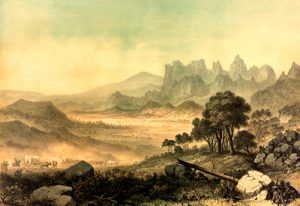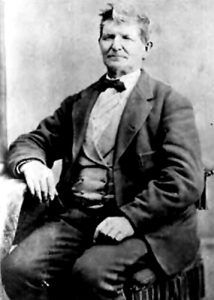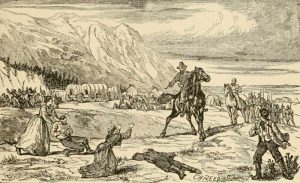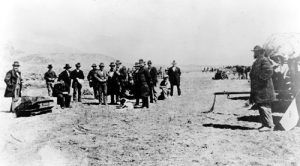John Doyle Lee was a pioneer and early prominent leader of the Mormon church in Utah. A leader in the Mountain Meadows Massacre, he was the only man ever to be punished for the 120 people who were slaughtered.
Lee was born in Kaskaskia, Illinois, on September 12, 1812. On July 24, 1833, he married Agatha Ann Woolsey, and a few years later, the pair joined the Mormon Church as early converts. He was a friend of the founder, Joseph Smith, Jr. In 1839, he preached in Illinois, Ohio, Kentucky, and Tennessee. A dedicated member, he took the church seriously, especially the polygamy policies, marrying another 18 wives during his lifetime and fathering more than 60 children. However, his choice of wives was evidently not so “dedicated,” as 11 would eventually leave him. Lee became a member of the Danites, a secret fraternal order pledged to defend the rights of Mormons; however, this has been disputed.
After Joseph Smith’s murder in Carthage, Illinois, Lee joined the Mormons and headed to Utah, where he became a prosperous farmer and rancher. In 1856, he became a U.S. government Indian Agent in the Iron County area, assigned to help Native Americans establish farms. Because of this role, Lee became the central figure in the tragic Mountain Meadows Massacre in September 1857.
When the Fancher wagon train was attacked in the four-day siege, Lee and William Bateman met with wagon train members and arranged for the surviving members to be escorted to safety under a flag of truce by the Mormon militia. The party surrendered their weapons, but as they were led away from their wagons, every male member was killed by Mormon militiamen, including Lee. The Paiute Indians killed the women and the older children. Only 17 small children were spared.
Though the government began an investigation the following year, Lee continued to be an active leader in Mormon affairs in southern Utah, so much so that he served a term in the Utah Territorial Legislature that year. Unfortunately, the Civil War interrupted investigations into the terrible tragedy, and the Mormons went on with their lives. However, by the late 1860s, questions about the massacre became more and more difficult to avoid. In October 1870, Brigham Young excommunicated Lee from the Mormon Church for his role in the affair. Though excommunicated, the church was still giving him orders, and in 1872 they sent him from Iron County to Arizona to establish a ferry crossing on the Colorado River.
Finally, the government continued its investigation, and in 1874, Lee was arrested. The first trial ended in a hung jury, but he was tried again in 1877 and sentenced to death. During his trial and in his written memoirs, Lee never denied his complicity, but consistently maintained he had acted under orders from his military leaders, under protest. Though he initially maintained that Mormon President Brigham Young did not know about the event until after it happened, he would later say: “I have always believed, since that day, that George A. Smith was then visiting southern Utah to prepare the people for the work of exterminating Captain Fancher’s train of emigrants, and I now believe that he was sent for that purpose by the direct command of Brigham Young.”
On March 23, 1877, Lee was taken to the massacre site, where he was executed by a firing squad. His last words included a reference to Young:
“I do not believe everything that is now being taught and practiced by Brigham Young. I do not care who hears it. It is my last word… I have been sacrificed in a cowardly, dastardly manner.”
His body was buried in the Panguitch Cemetery.
Though more than 50 Mormon men participated in the massacre, many of whom held high-level military roles and were admittedly aware of the attack plan, Lee was the only person to have ever been punished by the U.S. Government.
In April 1961, The Church of Jesus Christ of Latter-day Saints posthumously reinstated Lee’s membership in the church.

In this beautiful valley occurred one of the most horrific and controversial
massacres in U.S. history, drawing by H. Steinegger, Pacific Art Co, 1877.
©Kathy Alexander/Legends of America, updated March 2023.
Mountain Meadows Massacre – 1889 Account



